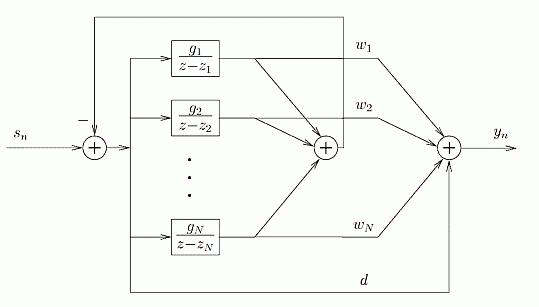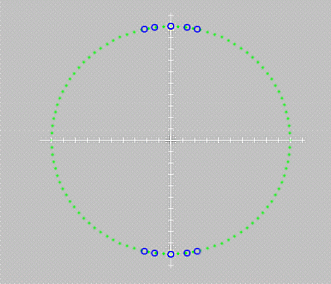|
Resonator-based Digital Filters
Implementation of digital filters has no theoretical
difficulties, but, there are practical problems, because of the finite
wordlength of signal processing devices. The problem arises mainly at the
implementation of IIR filters of hard specification. A filter can be realized by
many discrete systems, the behavior of them is not the same assuming finite
wordlength implementation. By completing the resonator-based observer a very
good filter structure can be made. In the following first the problems of the
digital implementation are reviewed, then resonator-based filters are
introduced.
Problems of Digital Implementation
Digital filters are linear, time-invariant discrete time
systems, their transfer function is a rational function of
z:

where B(z) and A(z) are
polynomials. The calculation of the filter generally can be done using the
following equation:

where x(n) and y(n) are the samples
of the excitation and the response at time instant n, respectively,
ai and bi are the coefficients of
A(z) and B(z), respectively. In the case of FIR
filters the second term of the sum is zero.
FIR and IIR filters are different, from implementation point of
view, as well. While FIR filters can be calculated by the above equation, it is
a rare occasion that IIR filters can be implemented this - so called direct -
way. The coefficients ai e.g. realize the denominator of
H(z). The relation between the roots and the coefficients is
highly nonlinear, and even a small coefficient mismatch results in a large root
difference. This is why quantized coefficients of the designed filter can lead
to unstable system. The greater the order of the filter, the more dangerous is
the direct implementation. If the system remains stable, it will be possibly out
of specification. Furthermore, the quantization error during the operation can
also lead to unstable system. Such problems are summarized in Fig. 1.

Fig. 1. Problems of digital implementation
Because of the problems mentioned above, the transfer function
H(z) is implemented by special structures. A common solution is
the decomposition of the transfer function into second order blocks, which can
be implemented directly. Serial or parallel connection of them realizes the
designed filter. Lattice and wave digital filters have very
good properties. During the operation the rounding should lessen the absolute
value of the number to be quantized. The resonator-based filter is also
a special structure. It has excellent sensitivity properties, does not need
scaling. Rounding towards zero guarantees that no limit cycles occur, and it
produces minimal noise.
Table 1. evaluates some structures, assuming several aspects.
The numbers in the table are marks used in the education. (The worst and best
marks in Hungary are 1 and 5, respectively.) The base of the evaluation is that
how the structure to be marked can be applied for the implementation of any
transfer function H(z).
| |
sensitivity |
demand for scaling |
stability |
computational demand |
|
FIR |
4 |
4 |
5 |
5 |
|
IIR, direct |
1 |
2 |
1 |
5 |
|
IIR, cascade |
4 |
3 |
4 |
4 |
|
IIR, parallel |
3 |
3 |
4 |
4 |
|
IIR, lattice |
3 |
4 |
5 |
4 |
|
IIR, wave digital |
5 |
5 |
5 |
3 |
|
IIR, resonator-based |
5 |
5 |
5 |
4 |
Table 1. Evaluation of different digital filter
structures
Resonator-based Filters
The block diagram of the filter can be seen in Fig. 2. The
input of the systems is sn, while yn is the
output. The resonator-based observer is completed by the coupling represented by
the multipliers wi, and by the coefficient d
representing the delay-free forward path.

Fig. 2. Resonator-based filter
The parameters of the structure can be calculated using the
original H(z) as follows:
1. The calculation of the forward coefficient is the
following:

i.e. it is the ratio of the zero-order terms in the transfer
function expressed as a function of z-1.
2. By the denominator A(z) one can determine the
roots of the following equation:

A(z-1) can be simply determined by
reversing the order of the coefficients of A(z). Since there are
two sings in the equation, the calculation results in two root sets. One of them
will be chosen as resonator set.
3. The following parameters are to be calculated for both root
sets:

which are real numbers if the calculation was precise.
zi, zj denote the potential resonator poles
and pj stands for the poles of H(z). The
resonator set is to be chosen for which the following inequality is
satisfied:

The coefficients gi in the figure can be
calculated as follows:

4. The coupling coefficients can be easily calculated by
sampling the original transfer function at the resonator frequencies:

As an example a tenth-order Cauer-type IIR filter can be
presented, the magnitude response of which can be seen in Fig. 3.

Fig. 3. Magnitude response of a tenth-order Cauer-type IIR
filter
The resonator poles are the following:

The resonator poles are indicated by small blue circles in Fig.
4. Note that the resonators are concentrated in the passband.

Fig. 4. Resonator pole locations on the complex plane. The green
circle is the unit circle.
The further parameters are the following:

The representation of these parameters is not a problem, even
if only fixed-point format is used. According to the experiences, the
resonator-based structure can implement IIR filters of very hard specification,
even if 16 bits fixed-point format is used.
Related Publications:
|
G. Péceli, "Resonator based digital filters", IEEE Transactions on
Circuits and Systems vol. CAS-36, pp. 156-159, Jan. 1989. |
Introduction to the resonator-based filters. |
|
T. Tölyhi, "Programozható digitális szuro
tervezése", M.Sc. thesis (in Hungarian), Budapest University of
Technology and Economics, Budapest, 2004, 99 p. |
Filtering of tight specification is carried out by resonator-based
filters. The thesis includes several measurement
results. |
Further publications on this topic can be found on this page.
Further information: László Sujbert
|